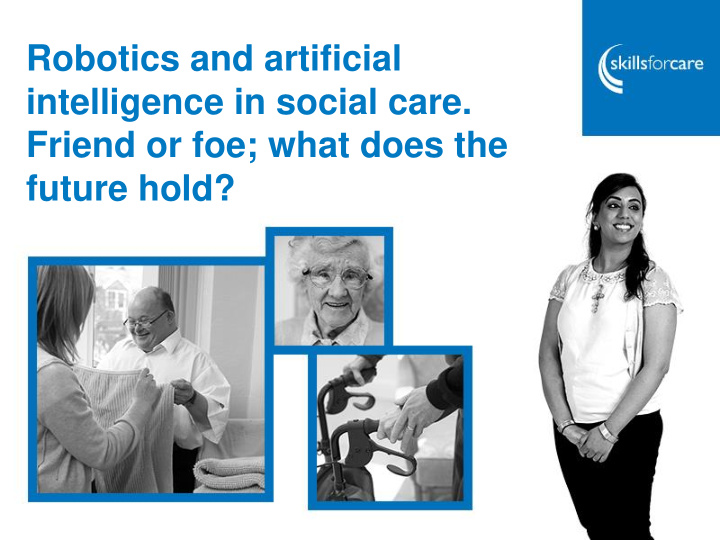



Robotics and artificial intelligence in social care. Friend or foe; what does the future hold?
Social care; now and in the future….
Now…. • Workforce turnover rate is now an average of 30.7% • There are 110,00 vacancies (8%) at any one time. • 25% of workers are employed on zero hours contracts. • Projected additional social care posts needed by 2035 is 950,000
Now. • The population in the UK is getting older with 18% aged 65 and over and 2.4% aged 85 and over (2016) • In 2016 there were 285 people aged 65 and over for every 1,000 people aged 16 to 64 years (“traditional working age”) • About 15 million people in the UK have a long term condition.
Now… • Long-term conditions are more prevalent in older people (58 per cent of people over 60 compared to 14 per cent under 40) • 1 in 8 adults (around 6.5 million people ) are carers. By 2037, it's anticipated that the number of carers will increase to 9 million
. Doing things differently seems to be not an option but a necessity ????
Skills for Care; what does new technology mean for the workforce? ‘The Emerging use of Artificial Intelligence and Robotics in Social C are’ https://www.skillsforcare.org.uk/Documents/Topics/Digital-working/Robotics- and-AI-in-social-care-Final-report.pdf
Typology; a broad categorisation of the types of AI and robotics emerging. • PAR ; Physically Assistive Robots • SAR; Socially Assistive Robots • CAR; Cognitive Assistance Robots (an emerging area of work) • Machine Learning.
This evidence review ; • Explores the literature in the context of AI and robotics and their uses in social care. • Explores what is currently happening with the use of this technology • Outlines the workforce issues that might occur as it’s usage rises.
Key findings • The evidence base demonstrating the effectiveness of AI and robotics in supporting care provision is relatively under- developed • Barriers for growing the use of AI and robotic systems include cost and a lack of understanding or even antipathy within the sector to their introduction.
Key Findings. • A notable gap in the evidence base relates to any assessment of the routes to market for the range of assistive robots that have been developed and piloted over the last decade. • Little evidence thus far on workforce implications.
This report acts as a discussion point for our sector. Our speakers today; Professor Praminder Caleb-Solly. Professor Gurch Randhawa. Professor Luc De Whitte.
Event agenda • Introduction • Brief presentation by each of our speakers. • Questions to speakers • Discussion in groups • Large group feedback with key messages • Coffee and tea; help yourself! • Slides available after the event.
Group discussion In each group start by introducing yourself and your interest in the subject to your group. As a group, discuss; What excited you about what you heard? What concerned you about what you heard? What do you see as the barriers for wide spread implementation of some of what you have heard about within social care? Please note these on your paper.
Recommend
More recommend